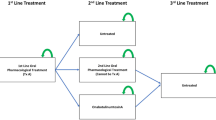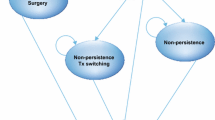Abstract
Objective: To evaluate the cost-effectiveness of a new extended-release (XL) formulation of oxybutynin relative to tolterodine immediate release (IR), currently the most prescribed treatment for overactive bladder in the UK.
Methods: A state-transition model was developed to compare outcomes over 1 year. Effectiveness and treatment persistence data were derived from the OBJECT (Overactive Bladder: Judging Effective Control and Treatment) study, a 3-month clinical trial comparing oxybutynin XL 10 mg/day with tolterodine IR 4 mg/day. The daily costs of oxybutynin XL and tolterodine IR were ££0.82 and £1.04, respectively. These data and information from the literature were used to project outcomes beyond the trial time. Severity-specific incontinence cost profiles were developed for the UK (2002 costings).
Results: After 1 year, 3.1 more patients per 100 treated attained complete continence with oxybutynin XL compared with tolterodine IR, and 5.6% more had less than seven incontinent episodes per week. Over 1 year, patients receiving oxybutynin XL had almost 17 additional incontinence-free days and 95 fewer incontinent episodes. Estimated costs were £86 lower per patient with oxybutynin XL. If drugs are priced equally, savings decrease to £21 per patient. Oxybutynin XL maintains its advantage over wide ranges of inputs, and outcomes are similar if analyses are limited to 3 months.
Conclusion: Base-case analyses suggest that oxybutynin XL provides better effectiveness than tolterodine IR and reduces costs. Results indicate that oxybutynin XL is the dominant therapeutic option under a wide range of alternative inputs and assumptions.




Similar content being viewed by others
References
Abrams P, Wein AJ. Introduction to the overactive bladder: from basic science to clinical management. Urology 1997; 50Suppl. 6A: 1–3
Abrams P, Blaivas JG, Stanton SL, et al. Standardization of the terminology of lower urinary tract function. Neurourol Urodyn 1988; 7: 403–27
Milsom I, Abrams P, Cardozo L, et al. How widespread are the symptoms of an overactive bladder and how are they managed? A population-based prevalence study. BJU Int 2001; 87: 760–6
Roe B, Doll H. Prevalence of urinary incontinence and its relationship with health status. J Clin Nurs 2000; 9: 178–88
Brown JS, Subak LL, Gras J, et al. Urge incontinence: the patient’s perspective. J Womens Health 1998; 7: 1263–9
Temmi C, Haidlinger G, Schmidbauer J, et al. Urinary incontinence in both sexes: prevalence rates and impact on quality of life and sexual life. Neurourol Urodyn 2000; 19: 259–71
Stoddart H, Donavan J, Whitley E, et al. Urinary incontinence in older people in the community: a neglected problem? Br J Gen Pract 2001;51: 548–52
The Continence Foundation. Making the case for investments in an integrated continence service: a sourcebook for continence services (2000). Available from URL: http://www.continence-foundation.org.uk/docs/prageb.htm [Accessed 2002 Aug 18]
Wagner TH, Hu T. Economic costs of urinary incontinence in 1995. Urology 1998; 5193: 356–61
Yarker YE, Goa KL, Fitton A. Oxybutynin: a review of its pharmacodynamic and pharmacokinetic properties, and its therapeutic use in detrusor instability. Drugs Aging 1995; 6(3): 243–62
Appell RA. The newer antimuscarinic drugs: bladder control with less dry mouth. Cleve Clin J Med 2002; 69(10): 761–9
Appell RA, Sand P, Dmochowski R, et al. Prospective randomized controlled trial for extended release oxybutynin chloride and tolterodine tartrate in the treatment of overactive bladder: results of the OBJECT study. Mayo Clin Proc 2001; 76: 358–63
Appell RA, Abrams P, Drutz HP, et al. Treatment of overactive bladder: long-term tolerability and efficacy of tolterodine. World J Urol 2001; 19: 141–7
Abrams P, Malone-Lee J, Jacquetin B, et al. Twelve-month treatment of overactive bladder: efficacy and tolerability of tolterodine. Drugs Aging 2001; 18: 551–60
Dmochowski RR, Appell RA. Advancements in pharmacologic management of the overactive bladder. Urology 2000; 56Suppl. 6A: 41–9
Diokno A, Sand P, Labasky R, et al. Long-term safety of extended-release oxybutynin chloride in a community-dwelling population of participants with overactive bladder: one-year study. Int Urol Nephrol 2002; 34(1): 43–9
Kobelt G, Jónsson L, Mattiason A. Cost-effectiveness of new treatments for overactive bladder: the example of tolterodine, a new muscarinic agents: a Markov model. Neurourol Urodyn 1998; 17: 599–611
Kelleher CJ, Cardozo LD, Khullar V, et al. A medium term analysis of the subjective efficacy of treatment for women with detrussor instability and low bladder compliance. Br J Obstet Gynaecol 1997; 104: 988–93
Desgagné A, LeLorier J. Incontinence drug utilization patterns in Québec, Canada. Value Health 1999; 2: 452–8
Boone TB, Kusek JW, Nyberg LM, et al. Treatment patterns and associated symptom improvement during six months of care for overactive bladder: a prospective, observational study. Clin Ther 2002; 24: 397–408
Netten A, Rees T, Harrison G. Unit costs of health and social care. Canterbury: Personal Social Services Research Unit, University of Kent at Canterbury, 2001
Katzman-McClish D, Wyman JF, Sale PG, et al. Use and costs of incontinence pads in female study volunteers: the Continence Program for Women Research Group. J Wound Ostomy Continence Nurs 1999; 26: 207–13
Kobelt G. Economic considerations and outcome measurement in urge incontinence. Urology 1997; 50Suppl. 6A: 100–7
Dowell CJ, Bryant CM, Moore KH, et al. Calculating the direct costs of urinary incontinence: a new test instrument. BJU Int 1999; 83: 596–606
Hu T, Wagner TH. Economic considerations for overactive bladder. Am J Manag Care 2000; 6Suppl. 11: S591–8
Wilson L, Brown JS, Shin GP, et al. Annual direct cost of urinary incontinence. Obstet Gynecol 2001; 98: 398–406
Arikian SR, Casciano J, Doyle JJ, et al. A pharmacoeconomic evaluation of two new products for the treatment of overactive bladder. Manag Care Interface 2000; 13: 88–94
Cannon T, Chancellor MB. Pharmacotherapy of overactive bladder and advances in drug delivery. Clin Obstet Gynecol 2002; 45: 205–17
Sussman D, Garely A. Treatment of overactive bladder with once-daily extended-release tolterodine or oxybutynin: the Antimuscarinic Clincal Effectiveness Trial (ACET). Curr Med Res Opin 2002; 18: 177–84
Noe L, Becker R, Williamson T, et al. A pharmacoeconomic model comparing two long-acting treatments for overactive bladder. J Manag Care Pharm 2002; 8: 343–52
Acknowledgements
This work was supported in part by a grant from Janssen Pharmaceutica, where authors W. Feng and D. Dubois are employed, to Caro Research, where authors D. Getsios, J. Caro, K. Ishak, W. El-Hadi, and K. Payne are employed and of which J. Caro is a shareholder. Caro Research has also received grants for unrelated research from Pfizer, the makers of products potentially affected by this work. Authors M. O’Connel and D. Albrecht are employees of ALZA Corporation. The sponsor collaborated in helping set the specifications for the model and by providing data on the OBJECT trial, but had no role in methodological decisions or interpretation of results. The sponsor was allowed to review and comment on this manuscript but was explicitly forbidden from exerting any editorial control.
Author information
Authors and Affiliations
Corresponding author
Rights and permissions
About this article
Cite this article
Getsios, D., Caro, J.J., Ishak, K.J. et al. Oxybutynin Extended Release and Tolterodine Immediate Release. Clin. Drug Investig. 24, 81–88 (2004). https://doi.org/10.2165/00044011-200424020-00003
Published:
Issue Date:
DOI: https://doi.org/10.2165/00044011-200424020-00003




